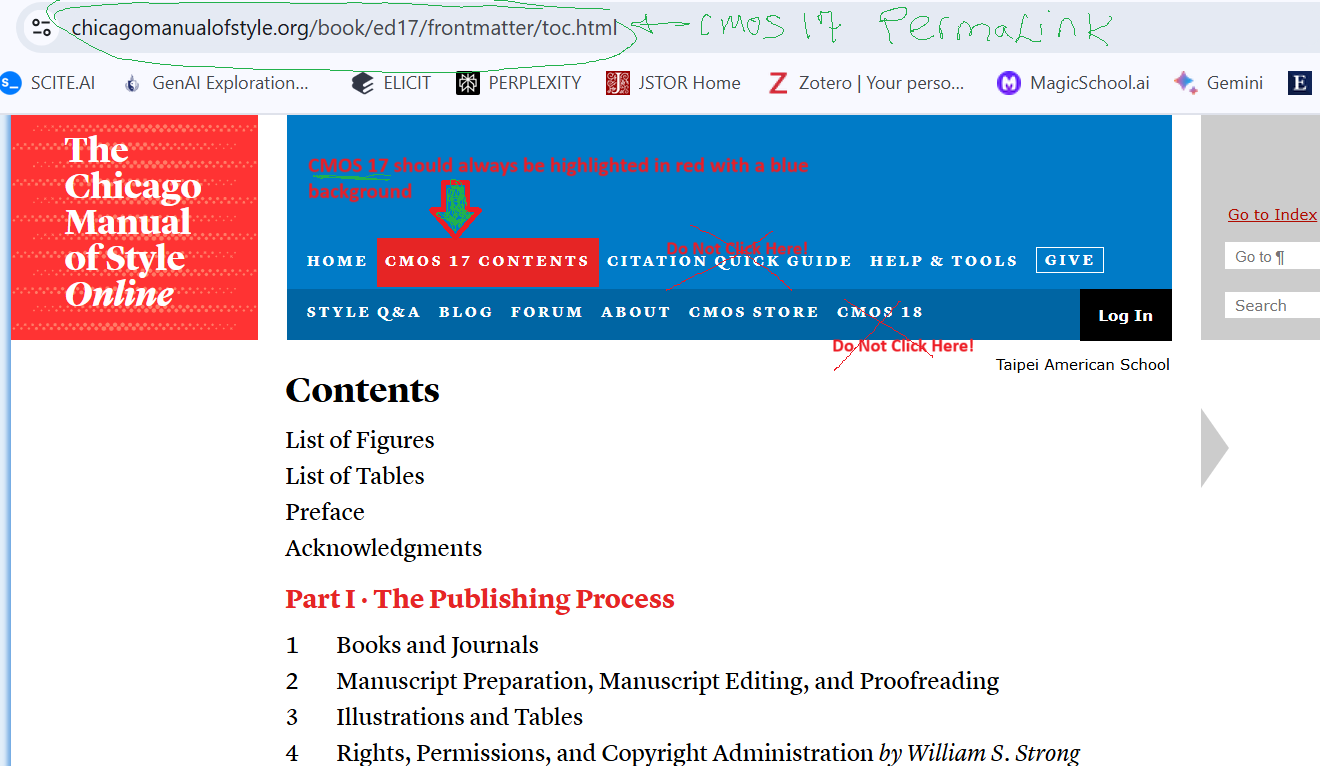Citing Your Sources
 Processing Request
Processing Request
*For information on how to cite ChatGPT & other AI, go to the left navigation bar and click on the last link
Download sources as you find them! Important notes about URLS:
- Include urls as required by your ciation system for online sources but always download the item as URLs do not always work.
- Use the doi as a url for a journal article when possible (doi = unique identifying # for the article) - e.g. https://doi.org/10.1186/s12889-021-10770-4.
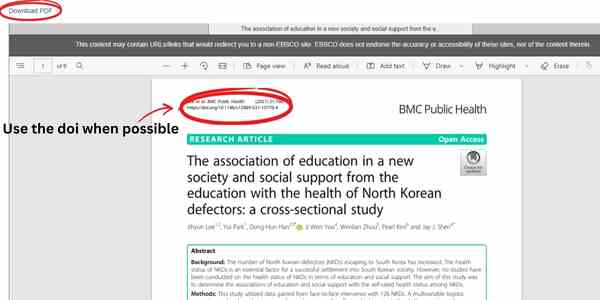
- The urls from our USIC search will not work. IF you have only the url, you'll have to find the document again by searching the highlighted part only from the url in our USIC search. There is not always an AN # though, so download.

Below are styles and basic outlines of their disciplines. Your teacher might require you to use a different citation styles for the disciplines below.
- History, Business, Fine Arts
- Literature, World Languages, Film, Performing Arts
- Psychology, Social Sciences
Comparison of APA, MLA, and CMOS.
TAS teachers might also require using one of the below systems.
- AMS - Mathematics from the Amer. Mathematical Society
- ACS - Chemistry from the Amer. Chemical Society
- AIP - Physics from the Amer. Institute of Physics.
- CSE - Science from the Council of Science Editors
For more information on which styles to use when, check the resources below, which have also been consulted to update this page. Remember: If your teacher tells you to use a particular style guide, that is the guide you should use!
- Record your source as soon as you find it! It can be difficult to go back and find a source again.
- Always follow the guidelines that your teacher gives even if they differ slightly from the citation rules.
- Have open an online or hard copy of the citation guide (Chicago, APA, MLA) while you are creating/fixing your citations.
- Always proofread when using a citation generator or database-generated citation before handing in your assignment. Generators and databases make mistakes.
- Citations have rules. Follow them consistently. Citations follow a pattern so that readers can easily recognize where to find the research you’ve used.
- Do NOT leave proofing your citations until the last minute. You need time to review as detail requires focus.
- For your own reference, do not rely on a URL to revisit your source. Record the database/website name as well as the author and title information even before formatting your citation.
On the back of the title page of a book, there is a page called the verso page. This page has information needed for your citation and, usually, an ISBN (which is handy if you are using Zotero). Please see the image below for an example of the information found on a verso page.
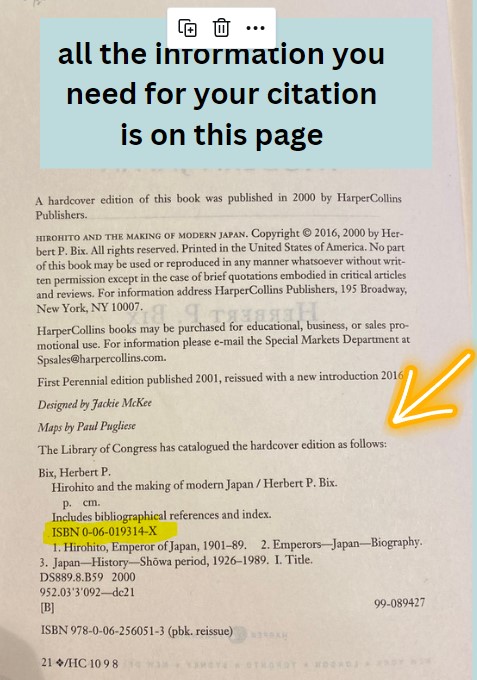
*For information on how to cite ChatGPT & other AI, go to the left navigation bar and click on the last link
EXAMPLE OF YOUR PAPER FORMATTED IN CHICAGO NOTES-BIBLIOGRAPHY
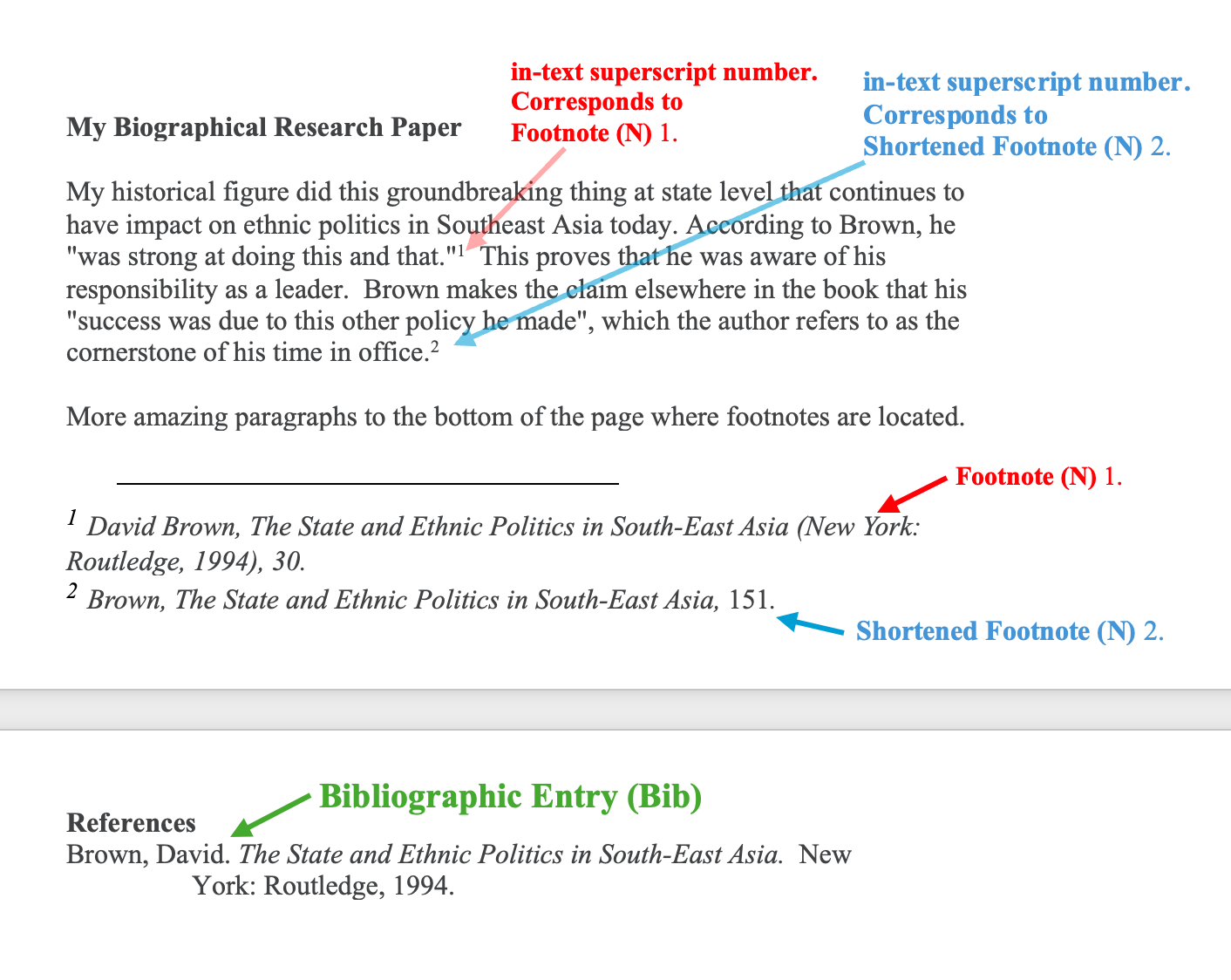
BOOK IN PRINT
-
Two or more authors.
(N) 1. Peter Morey and Amina Yaqin, Framing Muslims: Stereotyping and Representation after 9/11 (Cambridge: Harvard University Press, 2011), 52.
(N) 2. Morey and Yaqin, Framing Muslims, 60-61.
(Bib) Morey, Peter, and Amina Yaqin. Framing Muslims: Stereotyping and Representation after 9/11. Cambridge: Harvard University Press, 2011.
- Four or more authors, list all of the authors in the bibliography; in the note, list only the first author, followed by "et al."("and others"):
(N) 1. Jay M. Bernstein et al., Art and Aesthetics after Adorno (Berkeley: University of California Press, 2010), 276.
(N) 2. Bernstein et al., Art and Aesthetics, 18.
(Bib) Bernstein, Jay M., Claudia Brodsky, Anthony J. Cascardi, Thierry de Duve, Ales Erjavec, Robert Kaufman, and Fred Rush. Art and Aesthetics after Adorno. Berkeley: University of California Press, 2010.
- Editor or translator instead of author
(N) 1. Richmond Lattimore, trans., The Iliad of Homer (Chicago: University of Chicago Press, 1951), 91-92.
(N) 2. Lattimore, Iliad, 24.
(Bib) Lattimore, Richmond, trans. The Iliad of Homer. Chicago: University of Chicago Press, 1951.
- Editor or translator in addition to author
(N) 1. Jane Austen, Persuasion: An Annotated Edition, ed. Robert Morrison (Cambridge: Belknap Press of Harvard University Press, 2011), 311-12.
(N) 2. Austen, Persuasion, 315.
(Bib) Austen, Jane. Persuasion: An Annotated Edition. Edited by Robert Morrison. Cambridge: Belknap Press of Harvard University Press, 2011.
- Chapter or other part of a book
(N) 1. Angeles Ramirez, "Muslim Women in the Spanish Press: The Persistence of Subaltern Images," in Muslim Women in War and Crisis: Representation and Reality, ed. Faegheh Shirazi (Austin: University of Texas Press, 2010), 231.
(N) 2. Ramirez, "Muslim Women," 239-40.
(Bib) Ramirez, Angeles. "Muslim Women in the Spanish Press: The Persistence of Subaltern Images." In Muslim Women in War and Crisis: Representation and Reality, edited by Faegheh Shirazi, 227-44. Austin: University of Texas Press, 2010.
- Preface, foreword, introduction, or similar part of a book
(N) 1. William Cronon, foreword to The Republic of Nature, by Mark Fiege (Seattle: University of Washington Press, 2012), ix.
(N) 2. Cronon, foreword, x-xi.
(Bib) Cronon, William. Foreword to The Republic of Nature, by Mark Fiege, ix-xii. Seattle: University of Washington Press, 2012.
BOOK PUBLISHED ELECTRONICALLY
If a book is available in more than one format, cite the version you consulted. If you consulted the book in a library or commercial database, give the name of the database instead of a URL. If no fixed page numbers are available, you can include a section title or a chapter or other number.
(N) 1. Isabel Wilkerson, The Warmth of Other Suns: The Epic Story of America's Great Migration (New York: Vintage, 2010), 183-84, Kindle.
(N) 2. Philip B. Kurland and Ralph Lerner, eds., The Founders' Constitution (Chicago: University of Chicago Press, 1987), chap. 10, doc. 19, 2011, http://press-pubs.uchicago.edu/founders/.
(N) 3. Joseph P. Quinlan, The Last Economic Superpower: The Retreat of Globalization, the End of American Dominance, and What We Can Do about It (New York: McGraw-Hill, 2010), 211, ProQuest Ebrary.
(N) 4. Wilkerson, Warmth of Other Suns, 401.
(N) 5. Kurland and Lerner, Founders' Constitution.
(N) 6. Quinlan, Last Economic Superpower, 88.
(Bib) Wilkerson, Isabel. The Warmth of Other Suns: The Epic Story of America's Great Migration. New York: Vintage, 2010. Kindle.
(Bib) Kurland, Philip B., and Ralph Lerner, eds. The Founders' Constitution. Chicago: University of Chicago Press, 1987. http://press-pubs.uchicago.edu/founders/.
(Bib) Quinlan, Joseph P. The Last Economic Superpower: The Retreat of Globalization, the End of American Dominance, and What We Can Do about It. New York: McGraw-Hill, 2010. Accessed December 8, 2012. ProQuest Ebrary.
ENCYCLOPEDIAS AND REFERENCE WORKS IN PRINT
Please note that CMOS does not require a Bibliography listing for Britannica, but we have made an example for you. Some teachers require that all sources be in your bibliography.
(N) 1. Encyclopaedia Britannica, 15th ed., s.v. "Monroe Doctrine."
(N) 2. Encyclopaedia Britannica, s.v. "Monroe Doctrine."
(Bib) "Monroe Doctrine." In Encyclopaedia Britannica. 15th ed. Chicago: Encyclopaedia Britannica, 2002.
- Print Encyclopedias with an author and/or editor
(Bib) Isaacson, Melissa. “Bulls.” In Encyclopedia of Chicago, edited by Janice L. Reiff, Ann Durkin Keating, and James R. Grossman. Chicago: Chicago Historical Society, 2005.
(Bib) Masolo, Dismas. “African Sage Philosophy.” In Stanford Encyclopedia of Philosophy. Redwood City: Stanford University Press, 1997.
- Additional bibliographic entries for print encyclopedias or dictionaries
(Bib) Diccionario de historia de Venezuela. 2nd ed. 4 vols. Caracas: Fundación Polar, 1997.
(Bib) Garner, Bryan A. Garner’s Modern English Usage. 4th ed. New York: Oxford University Press, 2016.
(Bib) Middleton, Richard. “Lennon, John Ono (1940–1980).” In Oxford Dictionary of National Biography. Oxford: Oxford University Press, 2004.
ONLINE ENCYCLOPEDIAS OR DICTIONARIES
ARTICLES
In the footnote, you must include specific page numbers if there are page numbers. (Clue: If the bibliography entry has page numbers, your footnote must cite a specific page number). Journals have volume and issue numbers that need to be included.
- Article in an online journal
For a journal article consulted online, include a URL or the name of the database. For articles that include a Digital Object Identifier or DOI, form the URL by appending the DOI to http://dx.doi.org/ rather than using the URL in your address bar. The DOI for the article in the Brown example below is 10.1086/660696.
- Magazine article in print
(N) 1. Jill Lepore, "Dickens in Eden," New Yorker, August 29, 2011, 52.
(N) 2. Lepore, "Dickens in Eden," 54-55.
(Bib) Lepore, Jill. "Dickens in Eden." New Yorker, August 29, 2011.
- Newspaper article Online
Newspaper articles may be cited in running text ("As Elisabeth Bumiller and Thom Shanker noted in a New York Times article on January 23, 2013, . . .") instead of in a note, and they are commonly omitted from a bibliography. The following examples show the more formal versions of the citations.
(N) 1. Elisabeth Bumiller and Thom Shanker, "Pentagon Lifts Ban on Women in Combat," New York Times, January 23, 2013, http://www.nytimes.com/2013/01/24/us/pentagon-says-it-is-lifting-ban-on-....
(N) 2. Bumiller and Shanker, "Pentagon Lifts Ban."
(Bib) Bumiller, Elisabeth, and Thom Shanker. "Pentagon Lifts Ban on Women in Combat." New York Times, January 23, 2013, http://www.nytimes.com/2013/01/24/us/pentagon-says-it-is-lifting-ban-on-....
- Book review
(N) 1. Joel Mokyr, review of Natural Experiments of History, ed. Jared Diamond and James A. Robinson, American Historical Review 116, no. 3 (June 2011): 754, http://dx.doi.org/10.1086/ahr.116.3.752.
(N) 2. Mokyr, review of Natural,752.
(Bib) Mokyr, Joel. Review of Natural Experiments of History, edited by Jared Diamond and James A. Robinson. American Historical Review 116, no. 3 (June 2011): 752-55. http://dx.doi.org/10.1086/ahr.116.3.752.
THESIS, CONFERENCE PAPERS
- Thesis or dissertation
(N) 1. Dana S. Levin, "Let's Talk about Sex . . . Education: Exploring Youth Perspectives, Implicit Messages, and Unexamined Implications of Sex Education in Schools" (PhD diss., University of Michigan, 2010), 101-2.
(N) 2. Levin, "Let's Talk about Sex," 98.
(Bib) Levin, Dana S. "Let's Talk about Sex . . . Education: Exploring Youth Perspectives, Implicit Messages, and Unexamined Implications of Sex Education in Schools." PhD diss., University of Michigan, 2010.
- Paper (presented at a meeting or conference)
(N) 1. Rachel Adelman, " 'Such Stuff as Dreams Are Made On': God's Footstool in the Aramaic Targumim and Midrashic Tradition" (paper presented at the annual meeting for the Society of Biblical Literature, New Orleans, Louisiana, November 21-24, 2009).
(N) 2. Adelman, "Such Stuff as Dreams."
(Bib) Adelman, Rachel. " 'Such Stuff as Dreams Are Made On': God's Footstool in the Aramaic Targumim and Midrashic Tradition." Paper presented at the annual meeting for the Society of Biblical Literature, New Orleans, Louisiana, November 21-24, 2009.
- The basic format for a website
(N) “Title of Document/Webpage,” Title of the website, Author/Owner, last modified date or accessed date, URL.
(N) Author's last name, “Shortened title of Document/Webpage.” (If there is no author then put just the title of webpage/document. If you are citing a whole site and there is no author or webpage/document, just put the name of the site.)
(Bib) Author (and/or owner, sponsor). “Document/Webpage Title.” Title of Website. Updated or Accessed Date. URL.
- Websites
(N) 1. “Privacy Policy,” Privacy & Terms, Google, last modified April 17, 2017, https://www.google.com/policies/privacy/.
(N) 2. Google, “Privacy Policy.”
(Bib) Google. “Privacy Policy.” Privacy & Terms. Last modified April 17, 2017. https://www.google.com/policies/privacy/.
(N)1. “About Yale: Yale Facts,” Yale University, accessed May 1, 2017, https://www.yale.edu/about-yale/yale-facts.
(N) 2. “Yale Facts.”
(Bib) Yale University. “About Yale: Yale Facts.” Accessed May 1, 2017. https://www.yale.edu/about-yale/yale-facts.
(N) 1. Katie Bouman, “How to Take a Picture of a Black Hole,” filmed November 2016 at TEDxBeaconStreet, Brookline, MA, video, 12:51, https://www.ted.com/talks/katie_bouman_what_does_a_black_hole_look_like.
(N) 2. Bouman, “Black Hole.”
(Bib) Bouman, Katie. “How to Take a Picture of a Black Hole.” Filmed November 2016 at TEDxBeaconStreet, Brookline, MA. Video, 12:51. https://www.ted.com/talks/katie_bouman_what_does_a_black_hole_look_like.
- Blog entry or comment
Blog entries or comments may be cited in running text ("In a comment posted to The Becker-Posner Blog on February 16, 2012, . . .") instead of in a note, and they are commonly omitted from a bibliography. The following examples show the more formal versions of the citations.
(N) 1. Gary Becker, "Is Capitalism in Crisis?" The Becker-Posner Blog, February 12, 2012, http://www.becker-posner-blog.com/2012/02/is-capitalism-in-crisis-becker....
(N) 2. Becker, "Is Capitalism in Crisis?"
(Bib) Becker, Gary. "Is Capitalism in Crisis?" The Becker-Posner Blog, February 12, 2012. http://www.becker-posner-blog.com/2012/02/is-capitalism-in-crisis-becker....
- E-mail or text message
E-mail and text messages may be cited in running text ("In a text message to the author on July 21, 2012, John Doe revealed . . .") instead of in a note, and they are rarely listed in a bibliography. The following example shows the more formal version of a note.
(N) 1. John Doe, e-mail message to author, July 21, 2012.
- Comment posted on a social networking service
Like e-mail and text messages, comments posted on a social networking service may be cited in running text instead of in a note, and they are rarely listed in a bibliography. The following example shows how to integrate the information into running text.
Conan O’Brien’s tweet was characteristically deadpan: “In honor of Earth Day, I’m recycling my tweets” (@ConanOBrien, April 22, 2015).
If you must have a footnote, you can follow the example below.
(N) 1. Conan O’Brien, Twitter post, April 22, 2015, https://twitter.com/ConanOBrien.
LECTURE, SPEECH, OR READING
Live or in-person speech:
(N) 1. Barack Obama, "At This Moment We All Face a Choice." (speech, United Nations. General Assembly, New York, NY, September 20, 2016).
(N) 2. Obama, "At This."
(Bib) Obama, Barack. "At This Moment We All Face a Choice." Speech, United Nations. General Assembly, New York, NY, September 20, 2016.
Speech from a database or other source
Citing a transcript of the presentation in a book, anthology, website or database? A presentation broadcast on television/radio or archived as an online video or online audio recording?
(N) 1. Barack Obama, "At This Moment We All Face a Choice." speech, September 20, 2016, Academic Search Complete (119215940).
(N) 2. Obama, "At This," speech.
(Bib) Obama, Barack. "At This Moment We All Face a Choice." Speech, September 20,
2016. Academic Search Complete (119215940).
PHOTO OR PAINTING
- General example of order of photo or painting citation
(N) 1. Author First Name/Initial Surname, Image Title, Year, medium, size, Museum or Place image is, Location, URL.
(N) 2. Author full name, Image title.
(Bib) Author Surname, First Name or Initial. Image Title. Year. Medium. size. Museum or Place image is, Location, URL.
- Painting from a website
(N) 1. Francisco de Goya y Lucientes, General José de Palafox on Horseback, 1884, oil on canvas, 248 cm x 224 cm, Museo Nacional del Prado, Madrid, https://www.museodelprado.es/en/the-collection/art-work/general-jose-de-...?.
(N) 2. Francisco de Goya y Lucientes, General José de Palafox on Horseback.
(Bib) Goya y Lucientes, Francisco de.General José de Palafox on Horseback. 1884. Oil on canvas, 248 cm x 224 cm. Museo Nacional del Prado. Madrid. 2021. https://www.museodelprado.es/en/the-collection/art-work/general-jose-de-....
- Photo from a website
(N) 1. James Barnor, Mike Eghan at Picadilly Circus, London, 1967 printed 1010, gelatin silver print on paper, 281 × 283 mm. Tate. https://www.tate.org.uk/art/artworks/barnor-mike-eghan-at-picadilly-circ...
(N) 2. James Barnor, Mike Eghan at Picadilly Circus, London.
(Bib) James Barnor, Mike Eghan at Picadilly Circus, London. 1967 printed 1010. Gelatin silver print on paper. 281 × 283 mm. Tate. https://www.tate.org.uk/art/artworks/barnor-mike-eghan-at-picadilly-circ...
Photo from database (Sample below is untitled photograph.)
(N) 1. Central Press, A small group of North Vietnamese women undergoing rifle training before joining Viet Cong forces during the Vietnam War, photograph, September 11, 1967, Hulton Archive, Getty Image Collection (imh598600).
(N) 2. Central Press, A small group of North Vietnamese women undergoing rifle training before joining Viet Cong forces during the Vietnam War.
(Bib) Central Press. A small group of North Vietnamese women undergoing rifle training before joining Viet Cong forces during the Vietnam War. Photograph.September 11, 1967. Hulton Archive, Getty Image Collection (imh598600).
PRIMARY SOURCE DOCUMENTS
Use the formatting based on the type of source (video, etc.)
- Primary source document from website general format (Include the publication date of the website if found.)
(N) Author's first name last name, "Title of Primary Source Document: Subtitle," Title of Website, Date, website url.
(N) Author's first name last name, "Title of Primary Source Document (shortened)."
(Bib) Author's Last Name, First Name. "Title of Primary Source Document: Subtitle." Year of creation.Title of Website, Publisher of Website, Publication Date, URL.
- Primary source document found in a secondary source general format add url if source is online.
(N) Author's first name last name, description of primary source, Date, in Title of Secondary Source, ed. Editor's first name last name (Place of publication: Publisher, Year), pages.
(N) Last name, short description of primary source, pages.
(Bib) Author's last name, first name. Description of primary source, Date. In Title of Secondary Source, edited by Editor's first name last name. Place of publication: Publisher, Year.
- Primary source document found in a secondary source general format example
(N) Paulina Jackson to John Pepys Junior, October 3, 1676, in The Letters of Samuel Pepys and His Family Circle, ed. Helen Truesdell Heath (Oxford: Clarendon Press, 1955), 43-44.
(N) Jackson, letter to Pepys, 47.
(Bib) Jackson, Paulina. Letter to John Pepys Junior, October 3, 1676. In The Letters of Samuel Pepys and His Family Circle, edited by Helen Truesdell Heath. Oxford: Clarendon Press, 1955.
FAQ'S OF CITING IN CMOS
How do I find my article again?
- Download the full text of the article/book, if available, AND grab the full citation and permalink from your database. Using permalinks can be confusing. Ask the librarians in USIC if you have an issue finding an article again.
Do I need an access date?
- Maybe. Chicago Manual of Style no longer requires an access date for all online sources, but some databases and citation generators (NoodleTools, Zotero) still insert an access date. It is not wrong Academic sources including online journals and encyclopedias do not need access dates.
Do I need a url at the end of my citation?
Yes. Some online citations from databases including Google Scholar do not include the url. Copy the url or DOI (a url specific to a journal article) and place it after the last period in your citation. Put a period after the url.
What is the difference between a bibliography entry and notes?
- On this page the (Bib) means bibliography and this includes the most information as it appears on your bibliography page. Readers will go here for the complete information about your source. How to create an annotated bibliography.
- (N) means note. Your first footnote for a citation is longer than your second. Find more examples of bibs and notes in the Chicago manual itself.
What if my eBook or online article doesn't have specific page #s?
If no fixed page numbers are available, cite a section title or a chapter or other number in the notes, if any (or simply omit).
(1st N) Philip B. Kurland and Ralph Lerner, eds., The Founders’ Constitution (Chicago: University of Chicago Press, 1987), chap. 10, doc. 19, http://press-pubs.uchicago.edu/founders/.
(1st N) Jane Austen, Pride and Prejudice (New York: Penguin Classics, 2007), chap. 3, Kindle.
(2nd N) Kurland and Lerner, Founders’ Constitution, chap. 4, doc. 29.
(2nd N) Austen, Pride and Prejudice, chap. 14.
Do I put the country or state or just the city of a source in my bibliography?
Chicago requires only the city. You may put the abbreviation for a state or a country if the city exists in multiple places in the world.
I want to use a citation generator - any suggestions?
Zotero has an easy online citation generator, zbib.org. No citation generator is perfect. Proof your citations.
When using the zbib.org the first time:
- put in your ISBN or title first (or url, etc.)
- once you have a citation choose your citation style
- choose Chicago Manual of Style 17th edition Note and Bibliography (you might have to search the word Chicago)
Where is the citation information located in a print book?
On the back of the title page of a book, there is a page called the verso page. This page has information needed for your citation and, usually, an ISBN (which is handy if you are using Zotero). Please see the image below for an example of the information found on a verso or cip (cataloging-in-publication) page.
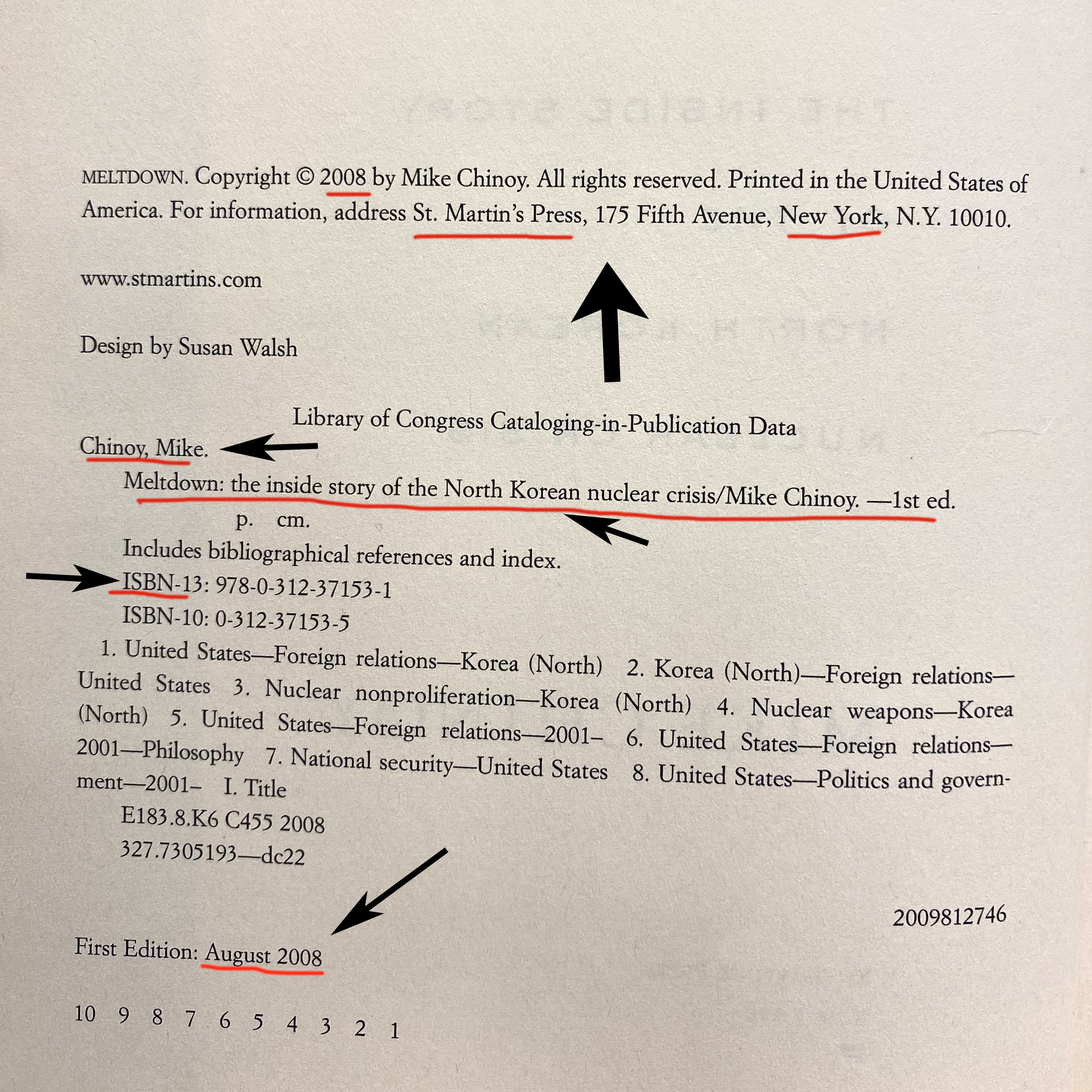
Sources:
Citations on this page are either taken from the CMOS Guide or created by your eLibrarian from the results of searches conducted on the Library's Single Search box.
A Note for History Students: When citing your sources, ensure you always stay within the 17th Edition of CMOS until your teacher approves the 18th Edition. Here is how:
- Click on the Permalink to the 17th Edition of CMOS,
- DO NOT click on "Citation Quick Guide" or "CMOS18." (at the top of the page) Clicking on any of these two links will take you out of the 17th Edition (pages have a blue and red banner).
- If you find yourself in the 18th Edition (grey banner, green nav bar), look for a link to CMOS 17 in the banner at the top of the page, or close and reopen the page.
The screenshot below shows you what the 17ths Edition looks like, and which links to NOT click on.
Having Difficulty? Talk to your Teacher or Librarian if you need more help with the online version of CMOS. Alternatively, to ensure you always stay within the 17th Edition when citing your sources, you can always use our beginner's guide to CMOS or the curated websites in the box titled "Selected formats for Sources from Chicago."
Owl Purdue CMOS site also has good examples for Chicago 17.
Sample Paper for Chicago (See an entire paper with examples of notes and the bibliography.)
Sample of a Bibliography See only the bibliography.
- Primary source document from website general format (Include the publication date of the website if found.)
(N) Author's first name last name, "Title of Primary Source Document: Subtitle," Title of Website, Date, website url.
(N) Author's first name last name, "Title of Primary Source Document (shortened)."
(Bib) Author's Last Name, First Name. "Title of Primary Source Document: Subtitle." Year of creation.Title of Website, Publisher of Website, Publication Date, URL.
- Primary source document found in a secondary source general format (from University of West Florida)
(N) Author's first name last name, description of primary source, Date, in Title of Secondary Source, ed. Editor's first name last name (Place of publication: Publisher, Year), pages.
(N) Last name, short description of primary source, pages.
(Bib) Author's last name, first name. Description of primary source, Date. In Title of Secondary Source, edited by editor's first name last name. Place of publication: Publisher, Year.
- Primary source document found in a secondary source - general format example
(N) Paulina Jackson to John Pepys Junior, October 3, 1676, in The Letters of Samuel Pepys and His Family Circle, ed. Helen Truesdell Heath (Oxford: Clarendon Press, 1955), 43-44.
(N) Jackson, letter to Pepys, 47.
(Bib) Jackson, Paulina. Letter to John Pepys Junior, October 3, 1676. In The Letters of Samuel Pepys
and His Family Circle, edited by Helen Truesdell Heath. Oxford: Clarendon Press, 1955.
On the back of the title page of a book, there is a page called the verso page. This page has information needed for your citation and, usually, an ISBN (which is handy if you are using Zotero). Please see the image below for an example of the information found on a verso page.

Always download the full article or book, if you can, and copy or export the full citation. URLS and permalinks might not work.
A note on citing online sources: Chicago Manual of Style 17 no longer requires an access date for online sources, but some databases still insert it their generated citations that's fine as long as you consistently insert them in your other citations. Just be consistent in how, when, and if you use an accessed date. It can be confusing to figure out what format is correct for online sources, but do your best and stay consistent.
Zotero
Zotero has an easy online generator, zbib.org, that supports CMS 17th edition. No citation generator is perfect and you should always check your work.
When using the zbib.org the first time:
- put in your ISBN or title first into the box
- once you have a citation choose your citation style
- choose Chicago Manual of Style 17th edition Note or Chicago Manual of Style 17th edition Note and Bibliography (you might have to search the word Chicago)
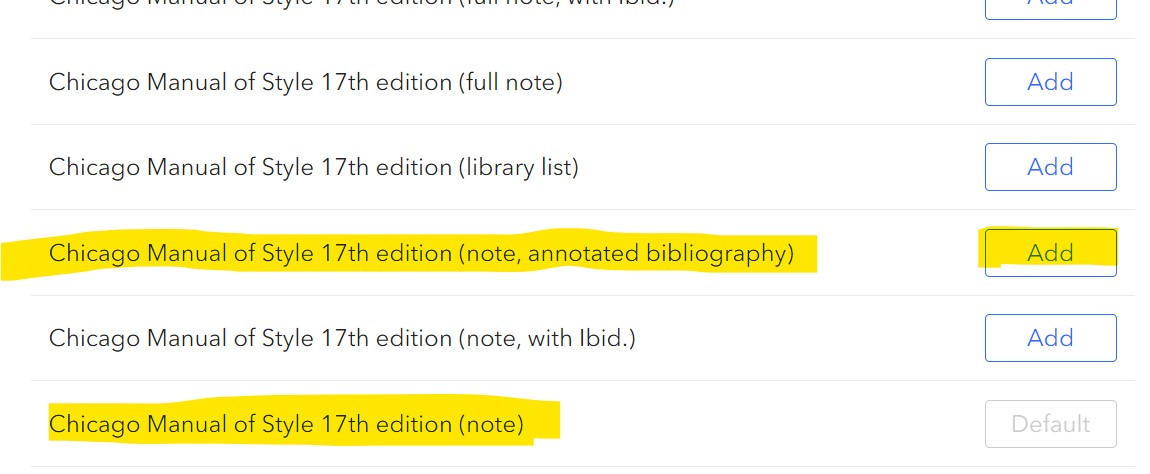
MLA (Modern Language Association)
MLA is used mainly for literature research, but it can also be used for other disciplines. It's currently in its 9th edition.
- Purdue OWL MLA Style has a description of the style plus examples of in text citations and works cited. Purdue takes its information from the 8th edition, which is fine as the latest edition, the 9th, adds more information to the 8th but does not change the citation style. For information on the difference between the 8th and 9th editions, see Purdue University's page.
- MLA Handbook, 9th ed., is available in the library. Ask for the book at the circulation desk.
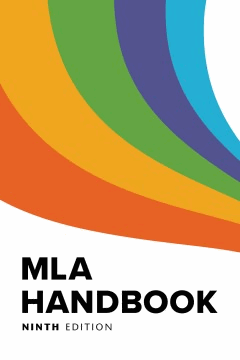
The most current APA Manual is the 7th edition.
- Look at Purdue University APA Guide website including examples and explanations of in text citations and reference lists. Purdue OWL APA Style also has sample papers.
- Check the many free resources on the APA website including examples and explanations of in text citations and reference lists (scroll down for examples).
- Ask for the Publication Manual of the American Psychological Association by American Psychological Association Staff, Call Number: REF 808 PUB, at the USIC desk.
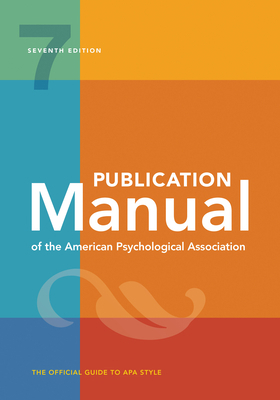
The American Mathematical Society has a mathematics style guide that uses a numbering system. Read about AMS and download the guide (large PDF) on the AMS site. There is no print version of this guide in the library, but the full guide (PDF) is online.
The American Institute of Physics has a style guide that is used mainly for physics. The information on this site is helpful. There is not a print guide, but there is a full version of the guide (pdf) online. Your teacher will tell you if you need to use this guide.
The American Chemical Society has a guide for chemistry research papers. You can find some information on the ACS site. Use this guide fro papers specifically about chemistry.
For research papers in science, students may use the Scientific Style and Format: The CSE Manual for Authors, Editors, and Publishers. There is a helpful online guide from the CSE as well as a Dalhousie university guide that has up-to-date information as of March 2022.
This Student Guide is created by AI for Education to help you decide when it is appropriate to use AI for a project or homework. The section "Yes, but" tells you when AI can be a useful research tool. Always consult your teacher before using AI so as to ensure it helps you meet your learning goals. Page updated March 6, 2024
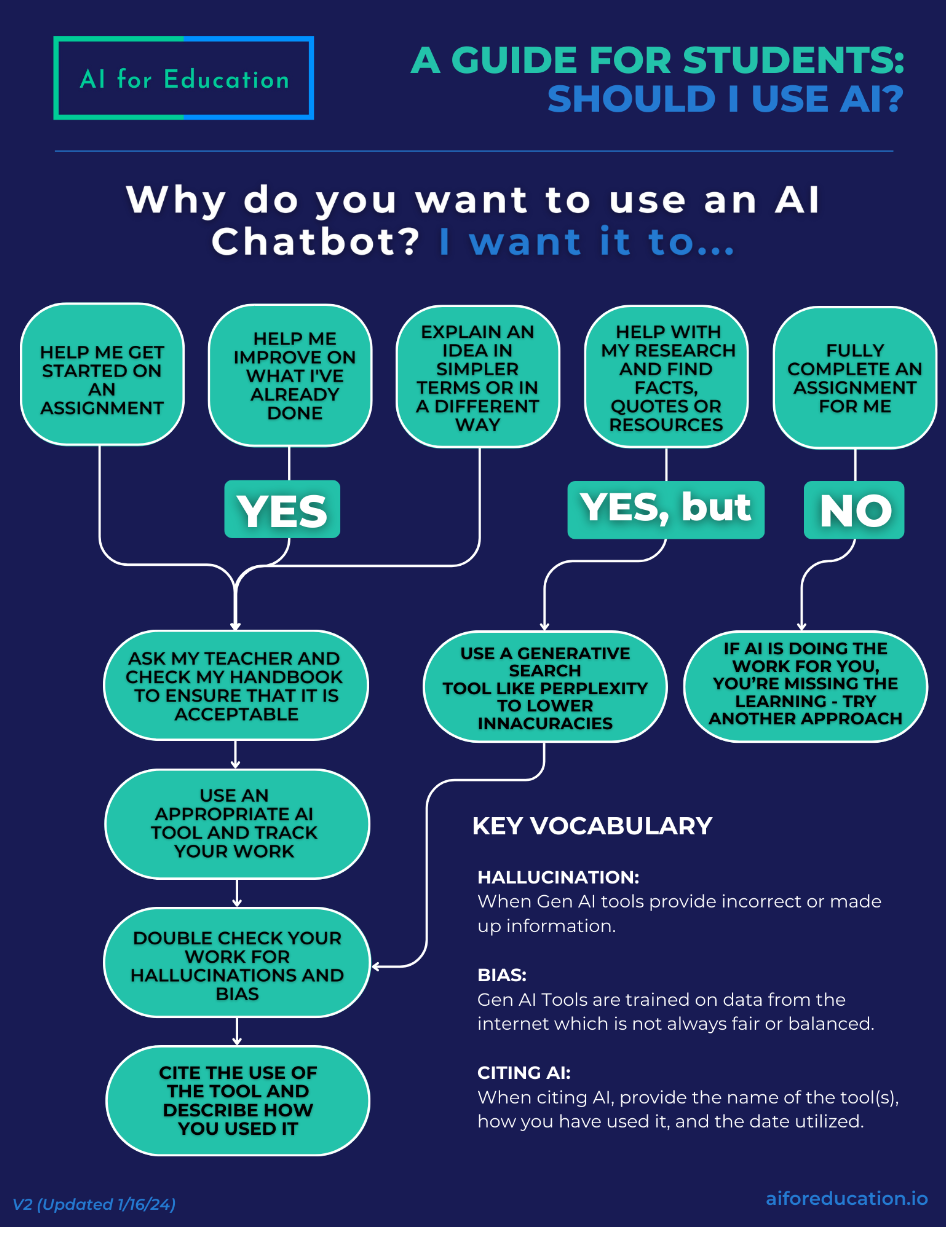
Below is some information on how to cite AI. Most style guides have sites with information on citing AI. (Google the style guide and the words AI or ChatGPT.)
Chicago 17th from Chicago Manual of Style FAQ
Chicago only requires a footnote and states that there is no bibliography format for citing AI
Footnote: Name of AI tool, response to "Prompt used to generate text, " Month, day, year, name of the company that developed the AI, URL.
Exampe: 1. ChatGPT, response to “Explain how to make pizza dough from common household ingredients,” March 7, 2023, OpenAI. https://chat.openai.com/chat.
MLA from the MLA page on Citing Generative AI
In-Text Citation
Format (Short form Title of source)
Example(“Describe the symbolism”)
Works cited
Format “Title of source” prompt. Name of AI Tool, version, Company, Date content was generated, General web address of tool.
Example “Describe the symbolism of the green light in the book The Great Gatsby by F. Scott Fitzgerald” prompt. ChatGPT, 13 Feb. version, OpenAI, 8 Mar. 2023, chat.openai.com/chat.
APA From APA Style
In-Text Citation
Example (OpenAI, 2023)
References
Example OpenAI. (2023). ChatGPT (Mar 14 version) [Large language model]. https://chat.openai.com/chat
The FAQ's of Citing AI in Academic Research - A Guide by Chicago Manual of Style Online
Q. How do you recommend citing content developed or generated by artificial intelligence, such as ChatGPT? Many scholarly publishers are requiring its identification though also requiring human authors to take responsibility for it and will not permit the AI to have “authorship.”
A. You do need to credit ChatGPT and similar tools whenever you use the text that they generate in your own work. But for most types of writing, you can simply acknowledge the AI tool in your text (e.g., The following recipe for pizza dough was generated by ChatGPT).
If you need a more formal citation—for example, for a student paper or for a research article—a numbered footnote or endnote might look like this:
1. Text generated by ChatGPT, OpenAI, March 7, 2023, https://chat.openai.com/chat.
ChatGPT stands in as “author” of the content, and OpenAI (the company that developed ChatGPT) is the publisher or sponsor, followed by the date the text was generated. After that, the URL tells us where the ChatGPT tool may be found, but because readers can’t necessarily get to the cited content (see below), that URL isn’t an essential element of the citation.
Footnote:
1. ChatGPT, response to “Explain how to make pizza dough from common household ingredients,” OpenAI, March 7, 2023.
If you’ve edited the AI-generated text, you should say so in the text or at the end of the note (e.g., “edited for style and content”). But you don’t need to say, for example, that you’ve applied smart quotes or adjusted the font; changes like those can be imposed silently (see CMOS 13.7 and 13.8).
But don’t cite ChatGPT in a bibliography or reference list unless you provide a publicly available link (e.g., via a browser extension like ShareGPT or A.I. Archives). Though OpenAI assigns unique URLs to conversations generated from your prompts, those can’t be used by others to access the same content (they require your login credentials), making a ChatGPT conversation like an email, phone, or text conversation—or any other type of personal communication (see CMOS 14.214 and 15.53).
[Editor’s update: Original answer updated to put the publisher before the date and to acknowledge tools like ShareGPT and A.I. Archives.]
To sum things up, you must credit ChatGPT when you reproduce its words within your own work, but unless you include a publicly available URL, that information should be put in the text or in a note—not in a bibliography or reference list. Other AI-generated text can be cited similarly.
Q. Robots are being named and even developing personalities, not just in fiction, but in the real world. Should their names be italicized—i.e., “I told Benjamin to wait at the coffee shop,” where Benjamin is a robot with artificial intelligence?
A. Italics for robot names could be fun in fiction; however, that doesn’t seem to be the convention either in fiction or in real life. (An exception is generally made for named spacecraft and the like, including the robotic Mars rover Perseverance; see CMOS 8.116.) Before you decide what to do, consider asking some robots to weigh in.
For some considerations on the use of AI in scholarly publishing and the responsibilities of authors, start with this position statement on authorship and AI tools from COPE (Committee on Publication Ethics). Here is the Statement. It provides links to other useful sources.
|
COPE position statement on Authorship and AI Tools: The use of artificial intelligence (AI) tools such as ChatGPT or Large Language Models in research publications is expanding rapidly. COPE joins organisations, such as WAME and the JAMA Network among others, to state that AI tools cannot be listed as an author of a paper. AI tools cannot meet the requirements for authorship as they cannot take responsibility for the submitted work. As non-legal entities, they cannot assert the presence or absence of conflicts of interest nor manage copyright and license agreements. Authors who use AI tools in the writing of a manuscript, production of images or graphical elements of the paper, or in the collection and analysis of data, must be transparent in disclosing in the Materials and Methods (or similar section) of the paper how the AI tool was used and which tool was used. Authors are fully responsible for the content of their manuscript, even those parts produced by an AI tool, and are thus liable for any breach of publication ethics. Related resources
First published: 13 February 2023 |
Want to learn More about ChatGPT and other chatbots? Who better to learn from about what Chatbots know than a CMOS Editor? Russell Harper, an Editor at CMOS, released an article on November 21, 2023, to bring awareness to Chat robots such as ChatGPT in academic research. The article is titled " What Do Chatbots Know?" and can be found by searching for the keywords "Artificial Intelligence" inside the Chicago Manual of Style Online
Content Source: Chicago Manual of Style Online, Accessed November 22-26, 2023
Guide edited for content March 6, 2024
Did you know? TAS subscribes to Chicago Manual of Style Online. Think of this as the eBook version of the physical, print manual that you can borrow from the Upper School Library. Use Keyword searches as well as an extensive, up to date menu of contents to learn how to cite properly, and to correct citations that you have generated from databases.
